Around 200 km from Mumbai, are the villages of Palashi and Mirje where the Naoroji Godrej Centre for Plant Research has converted an arid land into a home for 23 indigenous species of plants
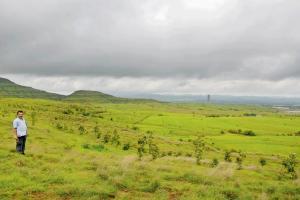
Sanjay Talekar in the background of afforested hillocks
Sanjay Talekar is a watchman with an unusual duty. He guards over 80,000 small and mid-sized trees - khair, neem, palash, lal sawar, shisam, awla, ritha, teak, ber - spread on hilly slopes over the 80 hectares located between the Palashi and Mirje villages of Satara district.
Talekar, an employee of Naoroji Godrej Centre for Plant Research (NGCPR), has been a witness to the growth of the trees from the time they were seeded in 2011, as part of a first-of-its-kind seven-year afforestation initiative in collaboration with the state forest department and Pune-based non-governmental group Maharashtra Vriksha Samvardhini. His duty as a guard is coming to a close this month as the centre hands over 80,000 trees - which have taken root amid cattle grazing, forest fires and poachers eyeing the bamboo and other fruit bearing vegetation - to the forest department.
ADVERTISEMENT
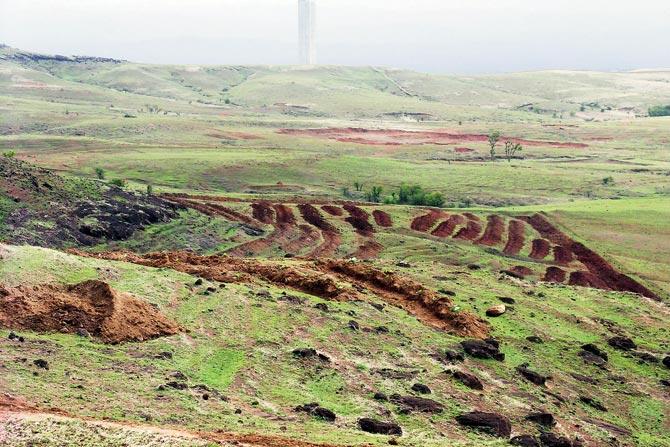
The same hills in 2012. Pics Courtesy/Dr Mayur Nandikar
In the appraisal of the afforestation experiment, done by the Wildlife Research and Conservation Society, Talekar, 43, a resident of the nearby Wing village, has been extensively interviewed about the experience of patrolling the hill slopes twice a day. He has expressed special concern about medicinal plants like sagargota (fever nut), makad shenguli (caralluma) and tarwad (cassia) which should be conserved at this stage, as they are a source of sustenance for surrounding villagers only after they achieve optimal growth. Talekar's words of caution stand out in the report because he is the resident stakeholder, who has protected the afforested slopes and woken up at unearthly hours to extinguish hundred-odd fires. As the joke goes, Talekar shoos away village boozers to "other spots" when they come with beer bottles and chakhna in the green hotspot. "Pyayla baryach jaga ahet… ithe nako (There are other places for liquor sessions. Leave these slopes)."
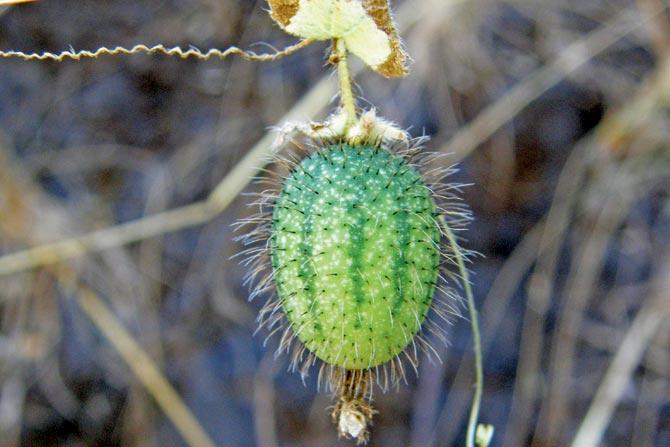
Cucumis setosus, known as Mehaki, and found around Torna fort
Talekar will soon resume his gardening responsibilities at NGCPR, Shirwal, a village four kilometres away from the afforested site. In fact, the eco-restoration plantation project took off on the 2.5 acres of the NGCPR campus whose herbarium, bamboosetum and an endemic plant conservatory-nursery played a key role in the assessment of the 66 suitable plant species (of which 23 are native), which could survive on the rocky, semi-arid hilly soil type receiving moderate rainfall. The local inhabitants, social forestry division and center's team, headed first by lead scientist Dr Tetali Pundarikakshudu and later Dr Mayur Nandikar, picked up seeds from the surrounding villages to rear around 1,30,000 saplings (of which around 80,000 have survived) which were then planted on the barren gradients over a period of two years.
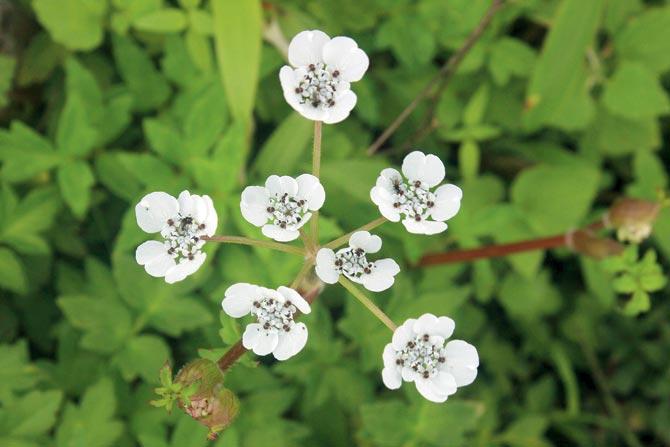
Pinda concanensis, known as Pand, and found in Torna fort
Incidentally, the NGCPR herbarium is recognised by New York Botanical Garden and has more than 2,700 plant specimens from the northern Western Ghats; it is known for conserving an endangered succulent herb frerea indica; it discovered an endangered tuberous wild edible flowering herb in the Pune-Satara region (brachystelma naoroji), which commemorates Naoroji Godrej in whose name the centre stands.
NGCPR is currently studying the genetic makeup of ledebouria varieties in order to arrive at the correct taxonomic classification of what is popularly called lasoon kanda. In fact, the centre is home to periodic workshops on taxonomic revisions, so that young researchers are not misled by ostensibly new species.
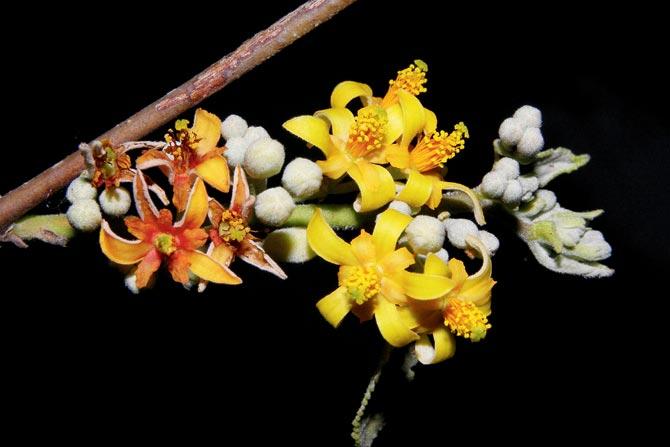
Flowers of Grewia tiliifolia aka Dhaman, found in the NGCPR campus
The centre's director, Vijay Crishna, feels NGCPR's next afforestation initiative will ideally be an independent one, as that can better empower the in-house experts to choose the appropriate flora, engage in long-term plant monitoring and share water conservation models, not to forget the elaborate fire line prep plan they have devised for excessively windy sites. The work at Palashi and Mirje involved collaboration with the gramsabhas, which called for initial awareness seminars with the villagers. In fact, the forest department has acknowledged efforts taken by the centre to "prepare the villagers for the experiment, much before tilling the land." It is expected that NGCPR's experiment may lead the way for other nonprofits to earn carbon credits by forging similar greening pacts.
In this context, the centre's initiative of studying the floristic diversity of Torna fort (50 km from the Shirwal campus) is also commendable. Dr Nandikar and team have explored the fort's topmost levels and brought to light 399 threatened plant varieties in the Torna precinct. Dr Nandikar has also pointed at the urgent need for conservation of other biodiverse fort sites. "Most forts around Mumbai and Pune are perceived as mere archaeological heritage, but they are also neglected habitats. They possess specific locales like flat summits, rocky flanks, crevices, precipitous slopes, which shelter extremely rich and rare plant diversity. We will lose it, if we don't restore the rare floristic varieties."
Just as NGCPR's focus on Torna is an attempt to bring attention to the threatened flora in most forts, its afforestation initiative is also not about the Palashi and Mirje villages. In fact, it is an effort to devise an Indiawide reference guide for plantation enthusiasts who zero in on exotic foreign origin trees. Mumbai is a live example of selection of wrong trees by the authorities who go after cosmetic fast-growing varieties which do not gel with the native climate. The most seen avenue trees of Mumbai are sonmohar (peltophorum) and gulmohar (delonix) which lead to severe clogging of its drainage system. "Anything that looks beautiful, doesn't necessarily suit the habitat. And it is not wise to go against the ecological niche," Dr Nandikar says, adding that plantation is an intense scientific activity, which should not be equated with greening; it has to be completed with an assessment of the native species; and who but the natives can be better judges of what suits the soil. The afforestation project at Palashi and Mirje set many precedents.
First, it implemented designs and techniques to reap a harvest in a rain shadow area.Similarly, it carried out a scientific monitoring of forest regeneration. For instance, species like neem (azadirachta indica) and lal sawar (bombax ceiba) regenerate even after getting burnt multiple times, however, many of the other species do not survive the effect, which were consciously avoided.
While India's forest policy mandates a 33 per cent forest cover in relation to the total geographical area, only 22 per cent is covered by trees. If we want the policy to be actualised, there is a long way to go. The slopes in Palashi and Mirje chart a green route.
Sumedha Raikar-Mhatre is a culture columnist in search of the sub-text. You can reach her at sumedha.raikar@gmail.com
Catch up on all the latest Mumbai news, crime news, current affairs, and also a complete guide on Mumbai from food to things to do and events across the city here. Also download the new mid-day Android and iOS apps to get latest updates
 Subscribe today by clicking the link and stay updated with the latest news!" Click here!
Subscribe today by clicking the link and stay updated with the latest news!" Click here!







